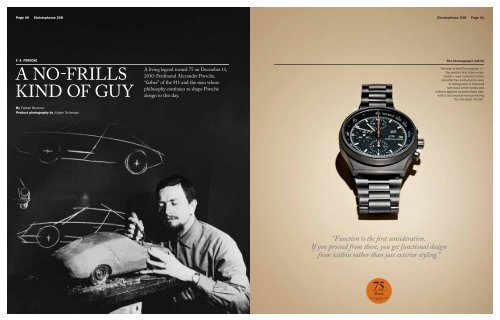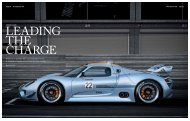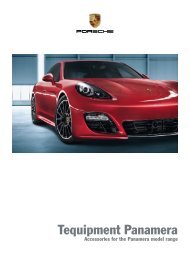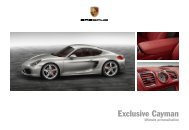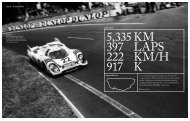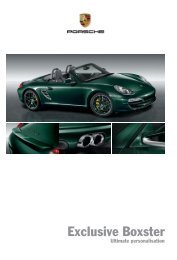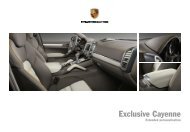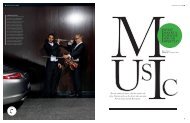Download PDF - Porsche
Download PDF - Porsche
Download PDF - Porsche
Create successful ePaper yourself
Turn your PDF publications into a flip-book with our unique Google optimized e-Paper software.
Page 40<br />
Christophorus 348<br />
Christophorus 348 Page 41<br />
F. A. PORSCHE<br />
A NO-FRILLS<br />
KIND OF GUY<br />
By Fabian Brunner<br />
Product photography by Jürgen Schwope<br />
A living legend turned 75 on December 11,<br />
2010: Ferdinand Alexander <strong>Porsche</strong>,<br />
“father” of the 911 and the man whose<br />
philosophy continues to shape <strong>Porsche</strong><br />
design to this day.<br />
The Chronograph I (1972)<br />
The look of the Chronograph I—<br />
the world’s fi rst black wristwatch—was<br />
modeled on the<br />
nonrefl ective instruments used<br />
in racing cars. It featured<br />
luminous white hands and<br />
indices against a matte black dial,<br />
with a red second-hand providing<br />
the only dash of color.<br />
“Function is the first consideration.<br />
If you proceed from there, you get functional design<br />
from within rather than just exterior styling.”<br />
75<br />
Years<br />
Ferdinand Alexander<br />
<strong>Porsche</strong>
Page 42 Christophorus 348<br />
Christophorus 348 Page 43<br />
“I just get a kick out of making things better —because in the<br />
end, I’m always also making them for myself.”<br />
His no-frills approach is as evident in the clean lines<br />
and clear-cut forms of his drawings as it is in the name<br />
he goes by: Professor Ferdinand Alexander—better<br />
known simply as F. A.—<strong>Porsche</strong>. It is equally manifested<br />
in the wording of the pronouncements in which his<br />
design philosophy is encapsulated, such as “design has<br />
to be honest” and “our products show what they can<br />
do.” F. A. <strong>Porsche</strong>, who celebrated his 75th birthday<br />
in December, has shaped the signature <strong>Porsche</strong> look<br />
more than any other single person. To his mind, design<br />
is about more than just looks or mere faddishness.<br />
Above all, he believes design should never be gimmicky<br />
or an end unto itself. And although he withdrew from<br />
the day-to-day business of the company that bears his<br />
name in the early 1970s, that uncompromising philosophy<br />
continues to inspire every product marketed under<br />
the name <strong>Porsche</strong> to this very day.<br />
Drawing the line<br />
F. A. <strong>Porsche</strong> working<br />
on the design of the<br />
904 Carrera GTS<br />
(1963)<br />
Exclusive shades (1978)<br />
Aviator shades are among the<br />
most popular kinds of sunglasses<br />
in the world. Thirty years after<br />
<strong>Porsche</strong> Design launched<br />
its fi rst aviators, it reissued<br />
the classic P’8478 model from<br />
1978 as part of its Heritage<br />
Collection. The P’8478 unites<br />
the charac teristic look of the<br />
1970s with the contemporary<br />
high-tech material titanium,<br />
which makes these sunglasses<br />
especially lightweight, fl exible,<br />
and robust.<br />
F. A. <strong>Porsche</strong> is widely regarded as a brilliant designer,<br />
and he has received numerous honors and awards<br />
over the course of his long and productive career. He<br />
is a purist, and his designs are characterized by timeless<br />
ele gance. Rather than chafing at the constraints<br />
imposed by the principle of “form follows function,”<br />
<strong>Porsche</strong> times three<br />
Ferry <strong>Porsche</strong> and his son F. A. in front of a portrait<br />
of F. A.’s grandfather Ferdinand (1960)<br />
he has always considered it a spur to his creativity and<br />
a challenge to be relished. What makes his work so<br />
fascinating is that the rational, no-nonsense approach<br />
he takes to realizing his ideas produces results that<br />
elicit such ardent enthusiasm. When F. A. introduced<br />
“his” first <strong>Porsche</strong> 911 (which was then known as the<br />
<strong>Porsche</strong> 901) in 1963, he explained the rationale behind<br />
its flowing lines and graceful curves by saying, “I<br />
wanted to create an absolutely neutral, no-frills car.”<br />
“Absolutely neutral”… well, that did not quite pan out.<br />
Even today, almost half a century later, the evolved 911<br />
is still one of the most “emotional” cars the automobile<br />
industry has ever produced. But F. A. <strong>Porsche</strong> is not just<br />
the father of the 911; he also designed all <strong>Porsche</strong> race<br />
cars in the 1960s, such as the <strong>Porsche</strong> 804, and above<br />
all the <strong>Porsche</strong> 904 Carrera GTS, widely regarded by<br />
automobile buffs as one of the most beautiful race cars<br />
of all time.<br />
F. A. <strong>Porsche</strong> came to the realization that design is inextricably<br />
linked to technology at an early age. Born in<br />
Stuttgart on December 11, 1935, as the oldest of Ferry<br />
and Dorothea <strong>Porsche</strong>’s four sons, he spent a lot of time<br />
as a child in the design offices and development workshops<br />
of his grandfather, Ferdinand <strong>Porsche</strong>. In 1943<br />
“Functional product design is<br />
the result of combining tradition and<br />
high-tech intelligently.”<br />
75<br />
Years<br />
Ferdinand Alexander<br />
<strong>Porsche</strong>
Page 44<br />
Christophorus 348<br />
Christophorus 348 Page 45<br />
Pipe (1983)<br />
The striking cooling fi ns on<br />
this pipe were inspired by the<br />
cooling ribs used in motorcycle<br />
engines. They create a larger<br />
surface area so that the pipe<br />
becomes less hot when<br />
smoked and the tobacco has<br />
a milder taste, thus enhancing<br />
smoking enjoyment.<br />
“Durability is a hallmark of good quality—and the basis<br />
for durability is excellent workmanship.”<br />
the family and the company relocated to Austria, and<br />
F. A. <strong>Porsche</strong> spent the next seven years attending school<br />
in Zell am See. After returning to Stuttgart in 1950, he<br />
finished at the local Waldorf school and enrolled at the<br />
College of Design in Ulm. In 1958, he began working<br />
for the family business and soon established a reputation<br />
for designing unique sports and race cars.<br />
Although F. A. <strong>Porsche</strong> and all the other family members<br />
withdrew from the operational business of <strong>Porsche</strong><br />
KG when it was converted into a publicly traded company<br />
in 1971/72, F. A. remained involved in the company’s<br />
fortunes. As a shareholder and member of the<br />
supervisory board, he oversaw the development of<br />
the newly established <strong>Porsche</strong> AG for many years and<br />
served as the chair of the supervisory board from 1990<br />
to 1993. In 2005 he passed the mantle of responsibility<br />
as a <strong>Porsche</strong> AG supervisory board member to his son<br />
Oliver, and became honorary chair of the board.<br />
Eye candy<br />
Ferdinand Alexander<br />
<strong>Porsche</strong> sketching<br />
the design for one<br />
of his legendary<br />
sunglasses models<br />
“My work as a designer is based on my own,<br />
very specific understanding of freedom. It demands<br />
a fundamental willingness to question everything<br />
and take full advantage of the latitude that that gives<br />
you, as conscientiously as possible.”<br />
75<br />
Years<br />
Ferdinand Alexander<br />
<strong>Porsche</strong><br />
Throughout his career, however, design remained<br />
F. A.’s true passion, and he founded the subsidiary<br />
<strong>Porsche</strong> Design in 1972 in Stuttgart. Two years later, he<br />
moved the company to Zell am See in Austria. With its<br />
spectacular views of the lake and the majestic Kitzsteinhorn<br />
and Grossglockner peaks serving as a source of<br />
inspiration, the town where he spent his youth proved<br />
to be the perfect environment for creativity to blossom.<br />
In the decades that followed, F. A. applied his prodigal<br />
talent primarily to designing classic men’s accessories<br />
such as watches, eyeglasses, and writing implements,<br />
which won the <strong>Porsche</strong> Design brand an international<br />
following of devoted fans.<br />
<strong>Porsche</strong> Design caused quite a stir when it launched the<br />
world’s first black wristwatch—its very first product—<br />
in 1972. The Chronograph I has long been regarded a<br />
classic and today is a highly coveted collector’s item. It<br />
is also a perfect poster child for F. A. <strong>Porsche</strong>’s design<br />
philosophy. The way he saw it, it was much more than<br />
just a decorative item of jewelry; it was a precision instrument.<br />
Accordingly, he modeled its look on that of<br />
the nonreflective instruments used in racing cars. After<br />
this milestone in watch design, F. A. <strong>Porsche</strong> and his<br />
team went on to design numerous industrial products,<br />
consumer goods, and household appliances for clients<br />
from all over the world.<br />
In 2003, F. A. <strong>Porsche</strong> and the other shareholders of<br />
<strong>Porsche</strong> Design joined forces with <strong>Porsche</strong> AG to found<br />
the <strong>Porsche</strong> Lizenz- und Handelsgesellschaft (PLH) in<br />
order to tap the potential of the <strong>Porsche</strong> name in sectors<br />
beyond the automobile. Its focus is on the <strong>Porsche</strong> Design<br />
trademark, which has its own marketing network<br />
and has in recent years become one of the world’s leading<br />
luxury brands. The <strong>Porsche</strong> Design Studio is still<br />
located in Zell am See, but it is now housed in a more<br />
prominent, glass and concrete building. F. A. <strong>Porsche</strong>’s<br />
successors are continually venturing into new territory,<br />
designing everything from sunglasses, watches, and<br />
shoes to a “kitchen for men,” yachts, and even the interior<br />
of a luxury catamaran. But even as the company<br />
continues to grow and evolve, in keeping with its founder’s<br />
spirit, one thing will probably never change: F. A.<br />
<strong>Porsche</strong>’s office in the Design Studio has remained untouched<br />
and looks as if this most gifted of designers will<br />
be returning to his desk any minute.
Page 46<br />
Christophorus 348<br />
Christophorus 348 Page 47<br />
PORSCHE DESIGN STUDIO<br />
STYLE PORSCHE<br />
THE TEN<br />
COMMAND-<br />
MENTS<br />
True to the spirit of <strong>Porsche</strong> Design Studio’s<br />
founder, Roland Heiler and his team in<br />
Zell am See aim to create timeless, honest<br />
design. Not content to design mere products,<br />
they make items that owners will cherish for<br />
their entire lifetime.<br />
FUTURE<br />
MODERN<br />
CLASSICS<br />
There’s a lot of F. A. <strong>Porsche</strong> in every <strong>Porsche</strong><br />
model. This should come as no surprise. As<br />
Michael Mauer, head of the <strong>Porsche</strong> Design<br />
department in Weissach, points out, the 911<br />
is the basis for the brand’s “design DNA” — and<br />
a key ingredient for making “future classics.”<br />
When Roland Heiler is asked about the approach he<br />
and his team take to their work, the head of the <strong>Porsche</strong><br />
Design Studio in Zell am See likes to use the TecFlex<br />
P’3110 ballpoint pen as an example. Its distinctive<br />
sheath is made of high-grade stainless-steel braided hose<br />
of the type used to sheath brake lines and electrics on<br />
high-performance cars. This high-tech material translates<br />
beautifully from the world of racing to the realm of<br />
writing instruments. It does not corrode, ensuring durability,<br />
and it feels great to the touch. But that is not all.<br />
Its flexibility has been harnessed to add functionality:<br />
to retract the ballpoint, one simply compresses the pen<br />
along its axis—the steel weave flexes and contracts accordingly.<br />
Heiler: “No cheap gimmicks, no trendy fads.<br />
We believe in credible, authentic design.”<br />
The rules are clear, the standard is high. The <strong>Porsche</strong><br />
Design Studio has always had a reputation for distinctive<br />
design of timeless elegance. “We want to make<br />
products that will stand the test of time,” says Heiler,<br />
“the kind that are passed down to the next generation.”<br />
The criteria to be applied in this endeavor were set down<br />
in writing by F. A. <strong>Porsche</strong> himself. Within the company,<br />
these rules are known as the “ten commandments.”<br />
But while everyone working in Zell am See is expected<br />
to be familiar with them, these “commandments” are<br />
not written in stone; the designers are encouraged to<br />
give their creativity free rein and think outside the box,<br />
too. The <strong>Porsche</strong> philosophy actually provides plenty<br />
of scope to design pretty much anything—the Design<br />
Studio team even designed a dentist’s chair once.<br />
The world of <strong>Porsche</strong> Design has traditionally been<br />
dominated by men, but that is gradually changing. As<br />
Heiler says, “We’re thinking about hiring more women<br />
designers, because a lot of women find our products<br />
appealing.” The company is committed to maintaining<br />
its high standards and proud tradition in the future<br />
while remaining innovative and evolving with the times.<br />
One way it has been working toward these goals in recent<br />
years is by systematically fostering and promoting<br />
young talents, with experienced staff members acting as<br />
mentors to student interns and graduate students.<br />
As diverse as the activities of the <strong>Porsche</strong> Design Studio<br />
are, the shared heritage and relationship with <strong>Porsche</strong><br />
cars are always discernible. As Heiler puts it, “Our affinity<br />
with the automobile designers at Style <strong>Porsche</strong><br />
is manifested not only in the forms and shapes of our<br />
products, but in our entire approach.”<br />
Photo: Bernd Kammerer<br />
Stepping into<br />
new territory<br />
The head of the<br />
<strong>Porsche</strong> Design<br />
Studio, Roland Heiler,<br />
with a shoe created<br />
by <strong>Porsche</strong> Design<br />
Of all the prizes the automobile designers at <strong>Porsche</strong><br />
have been awarded over the years, one that made<br />
Chief Designer Michael Mauer especially proud was<br />
the Springer publishing house’s designation of the<br />
new Cayenne as a “Future Classic.” “To launch a new<br />
car onto the market that’s deemed an instant classic is<br />
every automobile designer’s dream,” he says.<br />
And indeed, with its compellingly timeless design,<br />
the team at Style <strong>Porsche</strong> in Weissach has proven time<br />
and again that it can do the seemingly impossible: create<br />
cars that are supremely functional, yet surprising;<br />
always fresh, yet never gimmicky or faddish. Each<br />
model is distinctive, yet the signature <strong>Porsche</strong> look is<br />
always instantly recognizable—no mean feat. Mauer<br />
puts it this way: “Everyone working at Style <strong>Porsche</strong><br />
has to be able to walk the tightrope between introducing<br />
new style elements without starting a revolution.”<br />
The Style <strong>Porsche</strong> team manages this balancing act<br />
successfully because it follows the blueprint set out<br />
in the <strong>Porsche</strong> Design DNA, which goes back to the<br />
godfather of all <strong>Porsche</strong> models: the 911. The ultimate<br />
classic car, the 911 is the yardstick by which<br />
all <strong>Porsche</strong> models are measured in terms of lines,<br />
proportions, and certain style features to this day.<br />
“F. A. <strong>Porsche</strong> was the father of the 911, and there’s a<br />
lot of him in every <strong>Porsche</strong>,” says Mauer.<br />
Actually, F. A. <strong>Porsche</strong>’s influence goes even deeper<br />
than that. Mauer regards his statement that “our<br />
products show what they can do” as nothing short of<br />
brilliant. Style <strong>Porsche</strong>’s chief designer is convinced<br />
that “honest design” is the key to the enduring success<br />
of the <strong>Porsche</strong> brand. Of course, functionality cannot<br />
be the sole criterion when it comes to maintaining<br />
a distinctive brand identity, but it is nevertheless always<br />
a chief consideration at <strong>Porsche</strong>. As Mauer says,<br />
“Many of the cars we build can reach top speeds of<br />
well over 300 km/h [180 mph], so the air intake vents<br />
we design serve an important purpose. And our wheel<br />
rims are not only handsome; they’re also lightweight<br />
and show off the brakes and thus the high degree of<br />
safety that our vehicles offer.”<br />
Michael Mauer likes to surround himself with classic<br />
design at home, as well. He already owns a <strong>Porsche</strong><br />
Design toaster and coffee-maker, and he has been<br />
hunting for an original Chronograph I for years.<br />
“That watch was real dynamite.”<br />
Photo: Bernd Kammerer<br />
Back to the roots<br />
and into the future<br />
Michael Mauer, Chief<br />
Designer at Style<br />
<strong>Porsche</strong>, with a model<br />
of the “ur-”911


